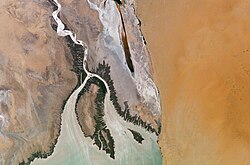Coloradoriverdelta oli APR2020
The wildlife, especially, entranced him. “A verdant wall of mesquite and willow separated the channel from the thorny desert beyond,” he continued. “At each bend we saw egrets standing in the pools ahead, each white statue mashed by its white reflection. Fleets of cormorants drove their black prows in quest of skittering mullets; avocets, willets, and yellow-legs dozed one-legged on the bars; mallards, widgeons, and teal sprang skyward in alarm.”
If he were to return and see today’s Colorado River Delta, Leopold would likely be amazed by how much it has changed. With most of the river’s water diverted into an irrigation canal near the U.S. - Mexico border, about 90 percent of the wetlands are gone. The mesquite and willow have largely been replaced by invasive salt cedar. And most of those verdant lagoons have turned into salt flats. Without an influx of nutrients from the river, far fewer species live in the estuary and Gulf of California.
In the natural-color satellite image above, the dendritic tidal creeks that flow into the gulf and tidal mudflats look like spindly fingers reaching into the sea. White salt flats and brown, shifting dune fields of the Sonoran Desert flank the delta and Montague Island. The Operational Land Imager (OLI) on Landsat 8 acquired the image on March 20, 2020.
There are still a few pockets of green that Leopold might find familiar. One of the largest, the Ciénega de Santa Clara wetland, formed by accident in the 1970s when the United States built a canal that drained salty irrigation runoff from farmland in Arizona. As the new source of moisture poured into the desert, an oasis of reeds, cattails, waterfowl, and other types of wildlife grew up around it, turning it into one of the largest wetlands in the area. Today, 280 species of birds spend their winters there.
NASA Earth Observatory images by Lauren Dauphin, using Landsat data from the U.S. Geological Survey. Story by Adam Voiland.| Diese Datei ist gemeinfrei (public domain), da sie von der NASA erstellt worden ist. Die NASA-Urheberrechtsrichtlinie besagt, dass „NASA-Material nicht durch Urheberrecht geschützt ist, wenn es nicht anders angegeben ist“. (NASA-Urheberrechtsrichtlinie-Seite oder JPL Image Use Policy). |  | |
 |
Warnung:
|
Relevante Bilder
Relevante Artikel
Colorado RiverDer Colorado ist der größte und wichtigste Fluss im Südwesten Nordamerikas. Er ist 2334 km lang und verfügt über ein Einzugsgebiet von 635.000 km². Landwirtschaft, Trinkwasser- und Elektrizitätsversorgung im Südwesten der Vereinigten Staaten und in Teilen Kaliforniens hängen stark vom Wasserregime des Colorado River ab. Dazu wurde zwischen dem Ende des 19. Jahrhunderts und den 1980er Jahren eine Vielzahl von Bewässerungsprojekten unterschiedlicher Größe verwirklicht. .. weiterlesen









